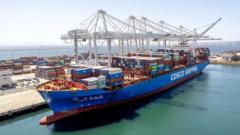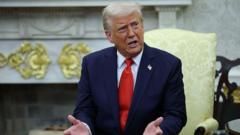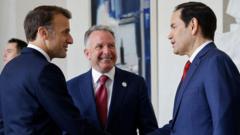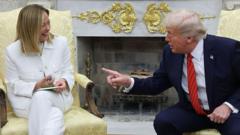In a recent announcement, President Donald Trump declared a temporary halt on increased tariffs affecting numerous nations, while simultaneously intensifying economic discord with China. The decision comes shortly after new tariffs were imposed on 60 of the U.S.'s trading partners. Under the restructured policy, a universal lowered tariff of 10% will apply as negotiations are pursued, but higher tariffs on Chinese goods will soar to 125%, with Trump criticizing China for a "lack of respect."
Trump Enacts Temporary Tariff Pause Amid Intensifying Trade Tensions with China
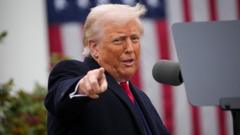
Trump Enacts Temporary Tariff Pause Amid Intensifying Trade Tensions with China
In a surprising pivot, President Trump pauses higher tariffs for 90 days while further escalating trade conflict with China.
The escalation of this trade war reverberates across global markets, following potential economic distress and heightened fears of a recession as market volatility increases. In the wake of initial tariffs being the catalyst for significant market turmoil, the U.S. government had seen a marked increase in interest rates, spiking to levels not seen since February. The abrupt shift to pause increased tariffs on other countries, however, fueled a recovery in U.S. stocks, witnessing a noteworthy surge in the S&P 500 index.
Trump revealed on his social platform that over 75 nations have reached out for trade negotiations, but the China situation remains dire, with their tariff on U.S. imports set to rise to 84% in retaliation. U.S. Treasury Secretary Scott Bessent emphasized that this pivot in tariff strategy was an independent decision despite market reactions, though some critics contend it signals weakness on Trump's part.
The ongoing standoff, characterized by tit-for-tat tariffs, initially initiated by Trump's tariffs earlier this year, represents a critical juncture in international trading relationships. With China firmly committing to respond aggressively against U.S. provocations, both governments remain entrenched in a high-stakes economic confrontation that threatens to reshape the global trade landscape.
Complete coverage of the latest developments in the U.S.-China trade war and its ramifications will continue as this situation unfolds.
Trump revealed on his social platform that over 75 nations have reached out for trade negotiations, but the China situation remains dire, with their tariff on U.S. imports set to rise to 84% in retaliation. U.S. Treasury Secretary Scott Bessent emphasized that this pivot in tariff strategy was an independent decision despite market reactions, though some critics contend it signals weakness on Trump's part.
The ongoing standoff, characterized by tit-for-tat tariffs, initially initiated by Trump's tariffs earlier this year, represents a critical juncture in international trading relationships. With China firmly committing to respond aggressively against U.S. provocations, both governments remain entrenched in a high-stakes economic confrontation that threatens to reshape the global trade landscape.
Complete coverage of the latest developments in the U.S.-China trade war and its ramifications will continue as this situation unfolds.

